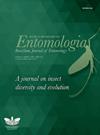Predatory capacity and intraguild interaction between aphidophagous predators in the control of rose bush aphids
IF 1.3
4区 农林科学
Q4 ENTOMOLOGY
引用次数: 0
Abstract
Chrysoperla externa (Hagen) and Hippodamia convergens (Guérin-Meneville) are voracious generalist predators, and important aphid control agents. In an environment containing a complex of species, the occurrence of intraguild interactions can interfere in the predator behavior and consumption. The aim of this work was to know the number of nymphs of Rhodobium porosum (Sanderson) and Macrosiphum rosae (Linnaeus) consumed by larvae of C. externa and H. convergens, and the interaction between these predators when confined together. First, second and third instar nymphs of R. porosum and M. rosae were provided in Petri dishes containing rose leaflets and second instar larvae of the predators. Intraguild interaction was studied in Petri dishes containing first instar nymphs of both aphid species and a second instar larva of C. externa plus one of H. convergens. A third treatment consisted of dishes containing a second instar larva of both predators maintained in the absence of prey. The evaluations took place throughout the entire instar of the predators. C. externa consumed a greater number of R. porosum nymphs and H. convergens a greater number of M. rosae nymphs. For both species of prey, the highest consumption was verified on the last day of evaluation. There was a positive interaction when the predator’s larvae were confined in the presence of aphid nymphs, with no mortality observed for any of them. In the absence of prey, there was 70% mortality of H. convergens larvae due to intraguild predation.食蚜天敌对玫瑰花丛蚜虫的捕食能力及相互作用
本文章由计算机程序翻译,如有差异,请以英文原文为准。
求助全文
约1分钟内获得全文
求助全文
来源期刊
CiteScore
1.50
自引率
12.50%
发文量
14
审稿时长
6-12 weeks
期刊介绍:
Information not localized

 求助内容:
求助内容: 应助结果提醒方式:
应助结果提醒方式:


